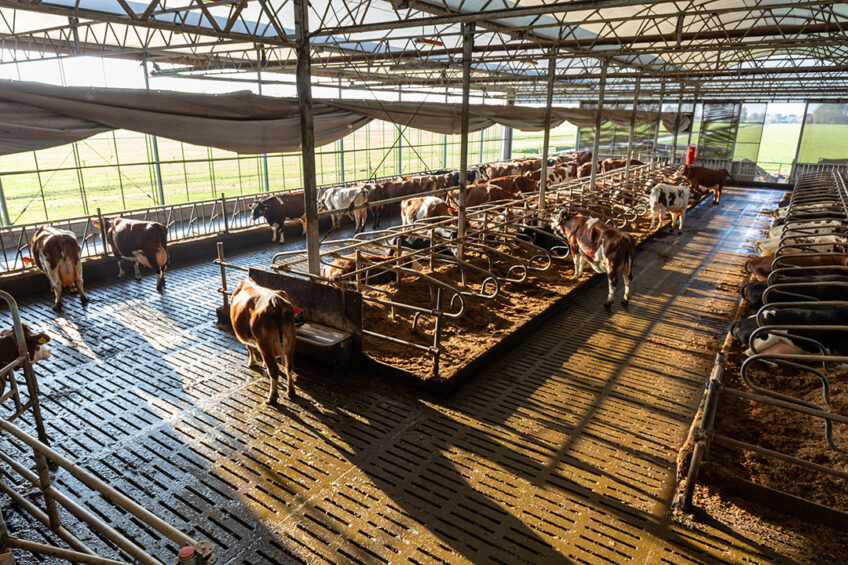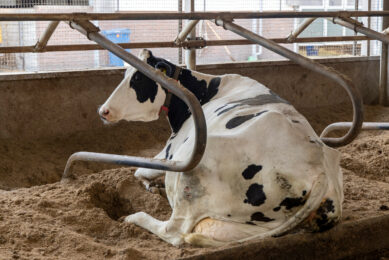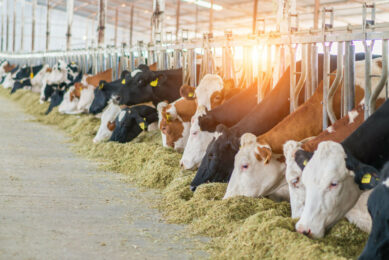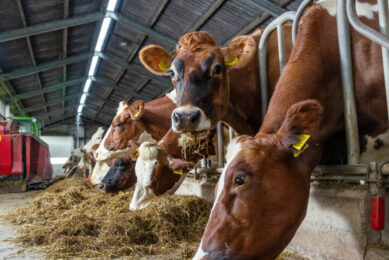Farm report: Dutch farm where dairy cows live longer

Chocolate-fed cows that live longer than the average dairy cow in the Netherlands are enjoying quite the life at a dairy farm situated in Bodegraven, South Holland province, where milk is also pasteurised and bottled on-farm.
Today the farm, run by Yvonne and Jorden Oostdam and their children, boasts 130 cows. The family farm was first in the hands of Jorden’s parents in 1972. In those days the farm had just 40 cows. In 1994 Jorden officially stepped into the family business to help run the farm, his wife Yvonne joined the business in 2001.
The 130 cows currently are a cross between Montbéliarde, Holstein and Swedish Red. The milk cows graze on 30 hectares of land, and the family also has an additional 15 hectares for other use.
ProfileName: Yvonne and Jorden Oostdam |
Welfare is a big issue for us, here we are always thinking of welfare on-farm and how we can make it better for the cows,” says Jorden Oostdam.
Welfare and longer life
“Our cows live about 1 year longer than the average cow in the Netherlands,” Yvonne says proudly. “We give them a good life and they are bred for longevity.” When the cows leave the farm they have produced about 43000kg milk. The average production from the Dutch cows leaving the farm is about 32000kg. Yvonne adds that the barn is light and airy with lots of natural light and air flowing through daily. The barn is relatively new and was built in 2008, keeping welfare of the cows in mind they wanted to have natural light and ventilation. “In the summer when it gets very hot, we have air coming out from the ventilation system which is situated above the cows, the air is blown on the back of the cows. This ventilation system helps to keep them cool.” Not only are the cows at the farm pampered with good ventilation and natural light. Yvonne says, “For more cow comfort there are no walls in this barn, the air flows through as the sides are kept open and there is a lot of light that comes in via the roof.” The sides of the barn are only closed during the winter when there is frost, otherwise it remains open during the year.
To ensure udder health, better performance and milk production, and lying comfort the farm opted to use deep bedding with recycled organic material which comes from a horse farm, it’s not too dry and it stays cleaner for longer. “The cows have a better grip when they get up and also it makes it easier for them to stand up,” adds Yvonne. “Welfare is a big issue for us, here we are always thinking of welfare on-farm and how we can make it better for the cows,” says Jorden.

Farm reports
Dairy Global regularly goes on-farm in leading dairy production sites around the globe.
Chocolate for energy
The cows get chocolate powder in their ration to boost energy and milk production. “There is no residue in the milk, we’ve made sure of that,” says Yvonne. Grass silage is mainly fed along with sugar beet pulp. After 20 years in the ration, it is the first year without maize in the feed. The family run business is always on the lookout for new ingredients that can be added to the cow ration. Together with an organisation that offers advice on feeding and new possibilities in the dairy ration, the family is always open to re-evaluating the ration every few months, along with a feed advisor.

Shorter lines between farmer and consumer
On this farm, the entire milk process takes place on-farm. The farm wanted to have shorter lines with the retailer and consumer, they became a part of Mijn Melk (‘My Milk’), an umbrella concept that aims to reduce the distance between farmers and consumers.
|
The Oostdam family also wanted to make the right choice when it came to selling their milk. One retail option that stood out was online Dutch supermarket Picnic.nl. Going this route also ensures that the line between farmer and consumer is shorter and that consumers can be reached directly, so this retailer was the logical option for the Oostdam family. Since February 19 this year, the farm has been selling milk via Picnic.nl. But of course all the logistics on-farm had to be put in place before this could happen. For the milk process, the family went with the Lely Orbiter, a system which is an on-farm milk processor.
Lely OrbiterAn on-farm automated dairy processing system. It processes milk directly from the Lely astronaut milking robots to the bottle. This ensures quality, optimal taste and creates a shorter route to the consumer. With this system dairy products can be traced up to cow level. This system lets the farmer have complete control with each milking. For more info, visit www.lely.com |
We believe in transparency and we have that with Lely,” says Jorden Oostdam.
Although timelines could differ on farm for installation of this automatic processor, on this particular farm it took around four months to get the system up and running. The Lely Orbiter processes the milk with a capacity of 300 litres per hour, and allows bottling and labelling also to take place all on-farm. This is the second Lely Orbiter in the Netherlands.

Once the milk goes through the process of pasteurisation, homogenisation and is bottled, labelled and packaged on-farm, it is then collected for distribution. “We believe in transparency and we have that with Lely,” says Jorden. Lely not only helped the farm with on-farm processing but also with advice on being better connected between farmer, retailer and consumer. In terms of sustainability retailer Picnic does its utmost to prevent food waste and this appeals to the Oostdam family, as running a sustainable farm is important to the family business. For delivery this retailer also uses no emission, 100% electric cars which take up less space, to deliver groceries, making them environmentally friendly. Currently, the bottled milk is available in 1 litre whole and semi-skimmed milk via Picnic.nl.
Future plans
When asked about what the future looks like for the Oostdam family and the dairy farm in Bodegraven, Yvonne says, “We want to of course see our products grow and offer additional sizes in bottled milk. We are also open to more retail possibilities.” The family wants to expand in other products too. “In the future we would like to see what we can do with our products by offering a wider range, by developing and testing how well products will do with consumers like higher protein milk, milk from grass-fed cows, A2 milk and barista milk, we will see what the possibilities are.” Yvonne adds that sales of A2 milk is very limited in the Netherlands, but she believes it is worth looking into in the future to see what the possibilities are. They are also keen to try and produce yoghurt in the near future. “We would like the number of consumers grow and of course keep the focus on the welfare of our animals and continue to operate in a sustainable way.”
Join 13,000+ subscribers
Subscribe to our newsletter to stay updated about all the need-to-know content in the dairy sector, two times a week.




 ‘Mijn Melk’
‘Mijn Melk’









